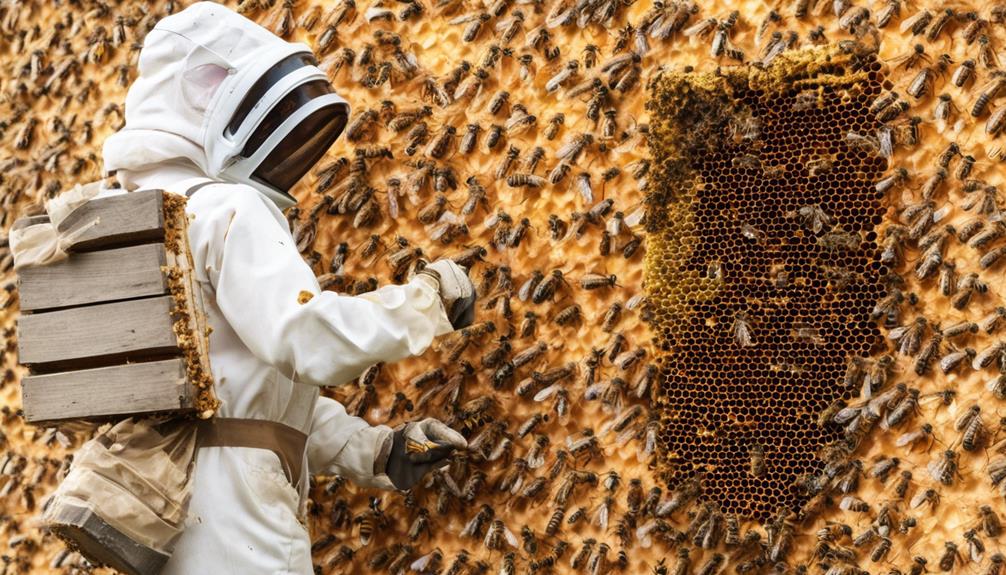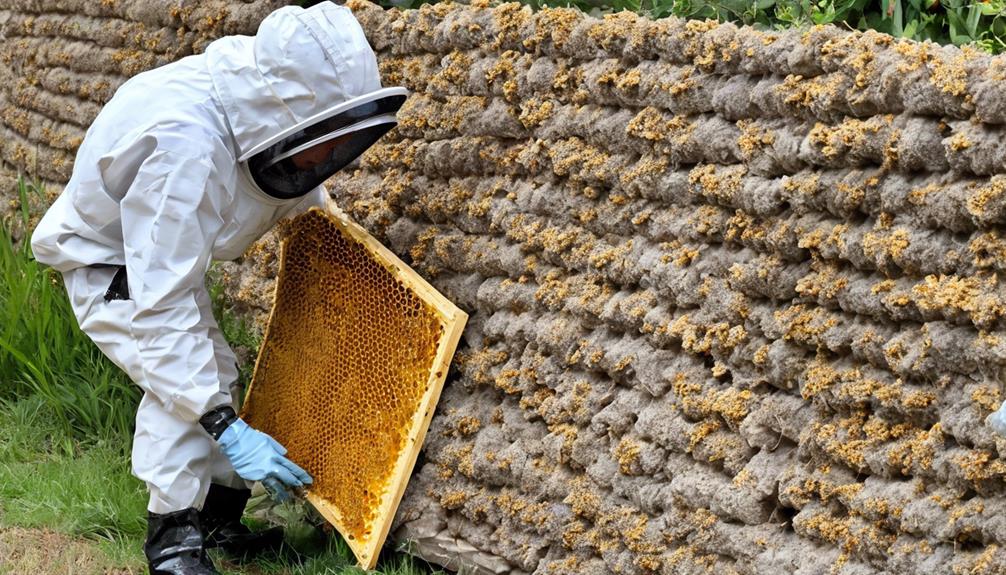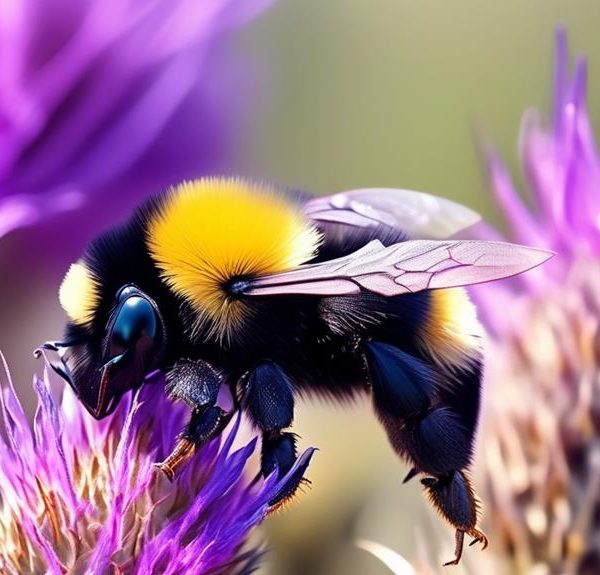Ignite your curiosity as we delve into safe and effective methods of eliminating a hidden danger: a bee's nest in your wall cavity.

How to Get Rid of Bees Nest in Wall Cavity?
Imagine you're battling a ticking time bomb hidden within your home's walls. That's right, we're talking about a bee's nest in a wall cavity.
It's a common yet dangerous situation that you might be facing. But don't worry, we've got some solid advice on how to handle this.
It's essential to understand the risks involved, the protective measures you should consider, and effective removal methods to ensure your safety and that of your home.
If you're curious about what comes next, let's just say it involves a comprehensive clean-up and a smart prevention strategy. Stick around, there's more to uncover.
Key Takeaways
- Identify signs of a bees nest in enclosed spaces like walls and attics.
- Use the construction of the nest to identify the type of bee (wax combs for honey bees, paper-like nests for hornets).
- Understand the risks of getting stung and the potential allergic reactions associated with multiple stings.
- Take proper protective measures, such as wearing a full-body bee suit and sealing entry points, before attempting bee removal.
Identifying a Bees Nest

Before you can effectively deal with a bee problem, you'll need to accurately identify the bees' nest. Don't assume it's just a harmless swarm, because if you're wrong, you could face significant problems.
First, you'll need to look for signs of a nest. Bees tend to build their nests in protected, enclosed spaces, so check your attic, walls, and even your garden shed. If you notice a large number of bees flying into and out of a particular location, it's likely a nest is nearby.
Next, try to identify the type of bee you're dealing with. Honey bees, for example, construct wax combs within their nests, while hornets create paper-like nests. If you're unsure, it's best to consult with a professional who can safely identify and remove the nest.
Understanding the Risks

Once you've located and identified the nest, it's crucial to understand the potential risks involved in attempting to remove a bees nest from your wall cavity. Your safety is paramount and there are real dangers you should be aware of.
The first risk is the high probability of getting stung. Bees are defensive creatures and will protect their colony if they perceive a threat. Multiple stings can cause serious allergic reactions, even if you've never had a problem before.
Secondly, honey bees, unlike wasps, can't sting repeatedly. When they do, they leave behind not only the stinger but also part of their abdomen, digestive tract, muscles, and nerves. This self-sacrificing act is fatal to the bee, meaning you're killing essential pollinators that our ecosystem relies on.
Lastly, the removal process can lead to structural damage in your home. Bees build extensive networks in wall cavities, and improper removal can weaken the structure. Additionally, leftover honey and wax can attract other pests, creating a new problem.
Protective Measures Before Starting

To ensure your safety during the removal process, it's essential to equip yourself with the right protective gear. Without adequate protection, you risk painful stings and potential allergic reactions. So, what should you wear? You'll need a full-body bee suit, gloves, and a bee veil to protect your face and neck.
Firstly, a full-body bee suit is a must. This suit should be light in color as dark colors can agitate the bees. It's best to choose a suit made from thick material to prevent stings from penetrating. However, it should also be breathable to keep you comfortable while working.
Next, invest in a good pair of gloves. Thick leather gloves are recommended as they offer maximum protection. Ensure the gloves are long enough to overlap with the sleeves of your suit, leaving no skin exposed.
Lastly, a bee veil is crucial. This mesh headgear will protect your face and neck without obscuring your vision.
Remember to seal all potential entry points of your suit, including wrists, ankles, and neck. The goal is to completely cover your skin, leaving no chance for the bees to sting you.
Preparedness is key – don't start until you're fully protected.
Effective Bee Removal Methods

Now that you're fully equipped, let's delve into the various effective methods for removing a bees nest from your wall cavity.
Firstly, you can try the 'smoke method'. This involves smoking out the bees to force them to vacate their nest. It's a commonly used technique, but it's essential to take extreme care not to start a fire.
Second is the soapy water method. A mixture of dish soap and water sprayed directly onto the nest can often kill the bees. However, this method can be risky as it may provoke the bees into defending their hive.
Another effective method is the use of insecticide dust. This is generally applied at night when bees are less active. Remember to wear protective clothing and use a dust applicator to reach the nest.
Lastly, if these methods seem too daunting, you can always hire a professional pest control service. They've the expertise to safely and effectively remove the nest.
Post-Removal Clean-up and Prevention

After successfully removing the bees' nest from your wall cavity, it's crucial to clean the area thoroughly and take preventative measures to avoid future infestations.
Start by scraping off any residue left by the bees. This includes honey, beeswax, and propolis, a resin-like material that bees use as 'caulk.' These residues can attract other pests or even a new swarm of bees.
You'll also need to sanitize the area, as the remnants of the nest can foster mold growth. Use a mixture of one part bleach to two parts water to disinfect the area. Ensure you're wearing protective gear, including gloves and a face mask, to avoid inhaling spores or coming into contact with the bleach solution.
Frequently Asked Questions
Can I Use Any Type of Insecticide to Get Rid of a Bees Nest in a Wall Cavity?
No, you can't use any type of insecticide to eliminate a bees nest in a wall cavity. It's crucial to choose a product specifically designed for bees. Using the wrong insecticide may not effectively kill the bees and could potentially harm other wildlife or your home.
Always remember that bees play a vital role in our ecosystem, so consider contacting a professional to safely remove the nest.
Is It Illegal to Remove a Bees Nest Without Professional Help?
It's not necessarily illegal to remove a bee's nest without professional help, but laws can vary by location. However, it's often discouraged due to the potential harm to you and the bees.
Bees play a critical role in our ecosystem, so it's best to have a professional safely relocate the nest. Be sure to check your local regulations before proceeding, as some areas do protect certain species of bees.
What Are the Potential Health Risks if I Get Stung by a Bee While Trying to Remove the Nest?
If you're stung by a bee, you might experience mild discomfort or severe allergic reactions. Initial symptoms include sharp pain, redness, and swelling.
If you're allergic, you could face anaphylaxis, a life-threatening reaction causing difficulty in breathing, hives, and rapid heartbeat.
Even if you're not allergic, multiple stings can lead to serious health issues like nausea, vomiting, diarrhea, dizziness, and fainting.
It's always safer to call a professional.
How Can I Ensure That Bees Will Not Return to Build a New Nest in the Same Location?
To ensure bees don't return to build a new nest, you've got to make the location unattractive to them. Start by sealing all cracks and crevices in the wall. Use caulk or foam sealant for small gaps, and for larger openings, consider hiring a professional to repair.
A fresh coat of paint can also deter bees. Remember, regular inspection and maintenance of your property is key to keeping it bee-free.
Can the Honey Produced by the Bees in the Nest Be Consumed Safely?
Yes, you can consume the honey produced by the bees in the nest safely. However, it's crucial to ensure the honey hasn't been exposed to pesticides or other harmful substances.
You'll also want to strain it to remove any debris.
Always remember, it's best to have a professional beekeeper handle the extraction to avoid harm to yourself and the bees.
Conclusion
In wrapping up, identifying a bee's nest in your wall cavity is crucial. Understand the risks involved and gear up with protective measures before initiating the removal process.
Application of effective bee removal methods is essential, followed by a thorough clean-up and prevention routine.
Take control, act responsibly, and ensure your home is bee-free. Always remember, professional help is available if the task seems too daunting.
You've got this!



